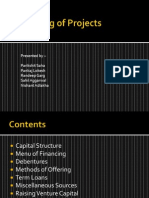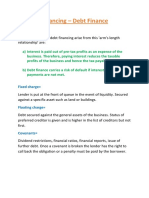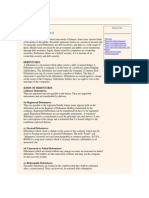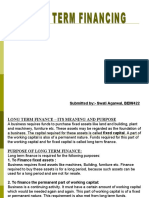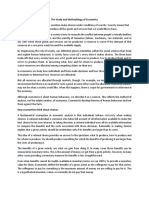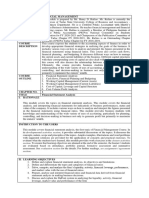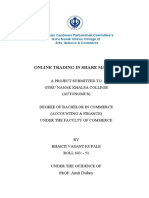End of Chapter Exercises - Answers: Chapter 2: Markets and Players
Uploaded by
YvonneEnd of Chapter Exercises - Answers: Chapter 2: Markets and Players
Uploaded by
Yvonne1
END OF CHAPTER EXERCISES - ANSWERS
Chapter 2 : Markets and Players
Q1 What constitutes “debt” and “equity” ?
A1
Broadly speaking debt consists of bank loans and corporate bonds issued by the company.
Preferred stock has attributes of both debt and equity but is usually classified as debt.
Q2 How do the rights of debtholders differ from the rights of equityholders?
A2
Debtholders (i.e. bondholders and suppliers of bank loans) have prior claims on the firm’s
cash flow. They are legally entitled to receive periodic payments (i.e. coupon or interest
payments) and the repayment of their principal. Debtholders do not receive any additional
payments when the company does exceptionally well. Debtholders can force the company
into liquidation if it fails to pay its periodic coupon/interest payments.
Equityholders have a security (a share certificate) which entitles the holder to receive
dividends as ratified at the AGM of the company. Shares do not have a redemption date – so
the company has not agreed to pay back the principal at a specific time in the future. After
paying taxes and interest payments on debt (and any repayments of debt principal), a
company’s earnings “belong to” the shareholders. Equityholders are ‘last in the food chain’
and only receive dividends after all debtholders have been paid.
Earnings which accrue to equityholders may either be distributed in dividends or retained by
the firm to finance projects with expected NPVs which are positive (which will then lead to
higher dividends in the future). The equity holders can vote on the future of the company
(e.g. at the AGM or “extraordinary” meetings) and can vote on the composition of the board of
directors. Debtholders cannot vote but they nevertheless have “influence” – particularly when
the company cannot pay all its debt interest payments.
Q3 Is preferred stock equity or debt?
A3
It is a “mixture” of both. The holders of preferred stock are paid after all the bondholders and
before the equityholders. The holders of preferred stock may receive no cash payments in a
particular year - but even than they cannot put the firm into liquidation.
Q4 What is an IPO? How does it take place?
A4
This is an initial sale of shares to the general public, in order to raise finance for the firm’s
future activities. The IPO will (usually) be organised by a large investment bank who will act
as underwriter of the issue. The bank will attempt to “build a book” of customers which will
show how many shares investors might wish to purchase at various prices. On the basis of
its estimate of demand for the new shares (at different prices), the bank will finally set a single
offer price for the shares. The underwriter will buy any shares not taken up by the public, so
the firm is guaranteed to receive the issue price times the amount of shares issued.
© K. Cuthbertson and D. Nitzsche (2008) ‘Investments’, J. Wiley, 2nd edition
2
Q5 What is a Eurobond (or international bond)?
A5
Eurobonds are bonds denominated in a currency which is different from the currency of the
country in which the bonds are issued. For example, a French firm issuing US-dollar
denominated bonds in Singapore or a French firm raising US-dollars in London are both
Eurobond issues.
Q6 What are the main types of bond issued by governments and firms?
A6
Governments usually issue conventional long dated bonds with fixed nominal coupons.
Some governments also issue index linked bonds which pay a guaranteed yield (usually
about 3%) above whatever the rate of inflation turns out to be in future years.
Companies issue long term fixed coupon corporate bonds as well as bonds with floating rate
coupons linked to LIBOR (these are Floating rate notes, FRNs). Some corporate bonds are
callable bonds (i.e. can be re-purchased at par if the issuer wishes, at specific future times)
and others might be convertible into shares (at the option of the holder), at some future date.
Q7 If you start a ‘high-tech’ firm, what are the initial likely sources of finance and how
would this change as the firm becomes successful?
A7
Your ‘own savings’ or re-mortgaging your house might be an initial source. Also, funds from
‘Business Angels’ or a secured bank loan might be used. Venture capitalists provide equity
finance would be a likely source when bringing the product to market. Early stage financing
might include issues of convertible bonds, since these give bondholders the opportunity to
convert their bonds in stocks, at a later date. Eventually, the firm might raise funds on the
secondary market (e.g. AIM in the UK or NASDAQ in the USA), before finally obtaining a full
listing and going public.
Q8 What are the possible risky for a private equity firm undertaking a leveraged buyout
(LBO) ?
A8
A leveraged buyout usually involves raising most of the finance for a takeover by issuing
bonds or taking out bank loans. These funds are used to purchase the shares of the target
company. Risk comes from the high level of (coupon) interest payments on the bonds and
debt interest payments on bank loans. If profits temporarily fall this may trigger insolvency
proceedings or result in a lower credit rating for the firm, which makes it more expensive to
issue further debt should this be required.
© K. Cuthbertson and D. Nitzsche (2008) ‘Investments’, J. Wiley, 2nd edition
You might also like
- Corporate Bond/ Debentures (Long Term) MarketNo ratings yetCorporate Bond/ Debentures (Long Term) Market92 pages
- Corporate Finance - SoF1 - Sources of Finance - StudentNo ratings yetCorporate Finance - SoF1 - Sources of Finance - Student19 pages
- Chapter 8: Money Markets and Capital Markets: Group 2No ratings yetChapter 8: Money Markets and Capital Markets: Group 251 pages
- Long Term Financing: An Introduction: University of Economics - Ho Chi Minh CityNo ratings yetLong Term Financing: An Introduction: University of Economics - Ho Chi Minh City22 pages
- Presented by - Parikshit Saha Pankaj Lokesh Randeep Garg Sahil Aggarwal Nishant Adlakha100% (1)Presented by - Parikshit Saha Pankaj Lokesh Randeep Garg Sahil Aggarwal Nishant Adlakha70 pages
- Equity Markets: Bulatao, Clemente, Dalope, Mercado, Nelmida, Ramilo, Santos100% (1)Equity Markets: Bulatao, Clemente, Dalope, Mercado, Nelmida, Ramilo, Santos206 pages
- CF - Questions and Practice Problems - Chapter 15No ratings yetCF - Questions and Practice Problems - Chapter 157 pages
- 2019 CIA P3 SIV 1E Capital Structure Capitl Budgeting Taxes and Transfer PricingNo ratings yet2019 CIA P3 SIV 1E Capital Structure Capitl Budgeting Taxes and Transfer Pricing133 pages
- Long-Term Financing: An: Mcgraw-Hill/IrwinNo ratings yetLong-Term Financing: An: Mcgraw-Hill/Irwin20 pages
- Primary Market - Where New Issues of Stocks and Bonds Are Introduced. InvestmentNo ratings yetPrimary Market - Where New Issues of Stocks and Bonds Are Introduced. Investment3 pages
- Debt Instruments - FAQ: Personal FinanceNo ratings yetDebt Instruments - FAQ: Personal Finance9 pages
- Debt and Equity Markets As Source of LT FinanceNo ratings yetDebt and Equity Markets As Source of LT Finance23 pages
- FM Group 2 Presentation Long-term Debt FinanceNo ratings yetFM Group 2 Presentation Long-term Debt Finance116 pages
- LECTURE 7 - Asset - Liability ManagementNo ratings yetLECTURE 7 - Asset - Liability Management19 pages
- End of Chapter Exercises - Answers: Chapter 16: Predicting Stock ReturnsNo ratings yetEnd of Chapter Exercises - Answers: Chapter 16: Predicting Stock Returns2 pages
- End of Chapter Exercises - Answers: Chapter 18: Spot and Forward MarketsNo ratings yetEnd of Chapter Exercises - Answers: Chapter 18: Spot and Forward Markets4 pages
- Cholelithiasis: - Other Names: - Gallbladder Attack - Biliary Colic - Gallstone Attack - Bile Calculus - Biliary Calculus100% (1)Cholelithiasis: - Other Names: - Gallbladder Attack - Biliary Colic - Gallstone Attack - Bile Calculus - Biliary Calculus101 pages
- Investigations of The Urinary System: Group 4No ratings yetInvestigations of The Urinary System: Group 453 pages
- The Utility Maximizing Bundle: 1 ReviewingNo ratings yetThe Utility Maximizing Bundle: 1 Reviewing12 pages
- Monopoly: Monopoly and The Economic Analysis of Market Structures100% (1)Monopoly: Monopoly and The Economic Analysis of Market Structures15 pages
- Analysis of Profitability, Liquidity and PerformanceNo ratings yetAnalysis of Profitability, Liquidity and Performance3 pages
- Mutual Funds ? - India: 9711844063 E-Mail IdNo ratings yetMutual Funds ? - India: 9711844063 E-Mail Id2 pages
- Quezon City University: Bachelor of Science in Accountancy50% (2)Quezon City University: Bachelor of Science in Accountancy13 pages
- Spicejet: Hot. Spicy. Spicejet Names All Its Aircraft With The Name of An IndianNo ratings yetSpicejet: Hot. Spicy. Spicejet Names All Its Aircraft With The Name of An Indian5 pages
- Introducing 23rd EY Europe Attractiveness Survey: Episode 1: 2 May 2024No ratings yetIntroducing 23rd EY Europe Attractiveness Survey: Episode 1: 2 May 20241 page
- Exercise 1-3: (Assets - Liabilities Shareholders' Equity)No ratings yetExercise 1-3: (Assets - Liabilities Shareholders' Equity)9 pages
- Solution Manual Advanced Financial Accounting 8th Edition Baker Chap016 PDFNo ratings yetSolution Manual Advanced Financial Accounting 8th Edition Baker Chap016 PDF50 pages
- Checkpoint Exam 3 (Study Sessions 16-19, 1)No ratings yetCheckpoint Exam 3 (Study Sessions 16-19, 1)11 pages
- ICICI Prudential SIlver ETF Distributor VersionNo ratings yetICICI Prudential SIlver ETF Distributor Version16 pages
- An Investment Guide To Rwanda: Opportunities and ConditionsNo ratings yetAn Investment Guide To Rwanda: Opportunities and Conditions60 pages
- Financial Analysis of Tata Steel: by Shubhank ShuklaNo ratings yetFinancial Analysis of Tata Steel: by Shubhank Shukla45 pages
- Basics of Financial Management: Assignment IINo ratings yetBasics of Financial Management: Assignment II24 pages
- Rabbit Farming Guide - Profitable Business If You Know Where You Are Heading ToNo ratings yetRabbit Farming Guide - Profitable Business If You Know Where You Are Heading To2 pages






























